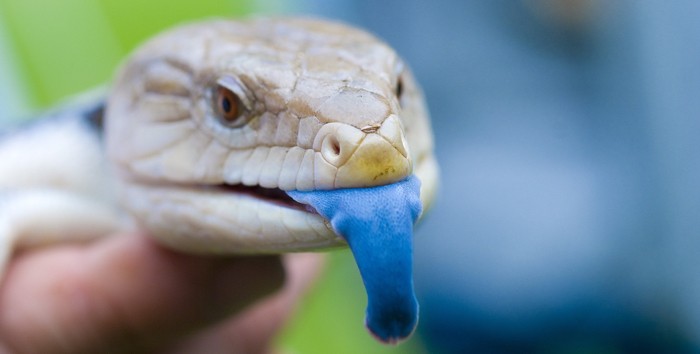Northern Blue-Tongued Skink (Tiliqua spp.)
Download the Skink Client Handout
Natural history
The blue-tongued skinks are represented by a variety of species, subspecies and races native to Australia, New Guinea and Indonesia. Two of the more common varieties in the pet trade are the northern, Tiliqua scincoides intermedia, and Irian Jaya, an undescribed T. scincoides. These ground-dwelling diurnal skinks have tiny legs and feet, heavy bodies, and a large, blue tongue that can be bared as a warning to potential enemies.
Some blue-tongued skinks are domestically bred, however many are imported from Indonesia and New Guinea.
Taxonomy
Class: Reptilia
Order: Squamata
Family: Scincidae-skinks, sandfish
Color and size
This large, heavy-bodied skink has ridged or “keeled” scales and dark crossbands. Pink to orange coloring is often found on the sides.
Adults reach 12-15 in (30-38 cm) in length.
Diet
Blue-tongued skinks are omnivores. They needs are best met by feeding a wide variety of foods:
- The bulk of the diet (45-60%) should consist of greens. Feed dark, leafy greens like mustard, kale, dandelion and collard greens. Mix vegetables with the salad such as peas, green beans, corn, squash, carrots, sweet potato, cucumber, zucchini, green peppers, and parsley.
- Also offer a protein source such as gut-loaded crickets, mealworms, and kingworms, snails, and the occasional pinky mouse. Some skinks may also accept earthworms. Juveniles eat more prey items than adults. Download the client handout: Feeding Insect Eating Reptiles for additional information.
- Fruit and blossoms may be offered as treats. Dust the non-breeding adult’s diet with a calcium carbonate or calcium gluconate supplement once weekly. Calcium supplements should be devoid or low in phosphorus with a minimum Ca:P ratio of 2:1. A general vitamin/mineral supplement may also be offered once weekly.
Feed adults every 1-2 days.
Husbandry
| Temperature | Provide a temperature gradient with a cool end of 70-85°F (21-29°C) and a basking spot of 92-100°F (33-38°C) at the opposite end. |
| Humidity/water | Maintain approximately 30% relative humidity Fresh drinking water should always be available. The bowl or tub should be large enough for the skink to easily access. |
| Cage size and design | At minimum, provide adults with a 40-55 gallon aquarium (or a cage of equivalent size), however these lizards have wide ranges in the wild and they will do best with much larger enclosures. |
| Cage furniture/supplies |
|
| Social structure | Must be housed alone; even juveniles will fight savagely. |
Lifespan
20+ years
Blue-tongued skinks are usually sexually mature by 2-3 years of age.
Anatomy/ physiology
Restraint
Blue-tongue skinks are considered to be very docile lizards, however always wash your hands before handling a skink to minimize the risk of smelling like one of their food items. Rawhide gloves help prevent scratches and give skinks a toe-hold while being held.
Never grasp a skink by the tail. Skinks possess tail autotomy, a defense mechanism that utilizes tail loss. A vertical fracture plane of fibroconnective tissue and cartilage runs through the body and part of the neural arch of each caudal vertebrae. The tail can fall off and will regrow as a cartilaginous rod, however skinks do not lose their tails easily.
Venipuncture
Preventive medicine
- Regular physical examinations
- Fecal parasite testing
- Quarantine
Important medical conditions
- Bite wounds (group housing)
- Nutritional secondary hyperparathyroidism or metabolic bone disease
- Obesity
- Cachexia from improper husbandry
- Blue-tongued skinks are relatively hardy, however common problems include:
**Login to view references**
References
References
Bartlett PB, Griswold B, Bartlett RD. Reptiles, Amphibians, and Invertebrates: An Identification and Care Guide, 2nd ed. Hauppage, NY: Barron’s Educational Series; 2010.
Bull CM, Pamula Y. Sexually dimorphic head sizes and reproductive success in the sleepy lizard Tiliqua rugosa. J Zool 240(3):511-521, 1996.
Wareham DC. Blue-tongued skinks. Advanced Vivarium Systems. 2012.
Pollock C. Basic information sheet: Northern blue-tongued skink. May 31, 2012. LafeberVet Web site. Available at https://lafeber.com/vet/basic-information-for-the-northern-blue-tongued-skink/
